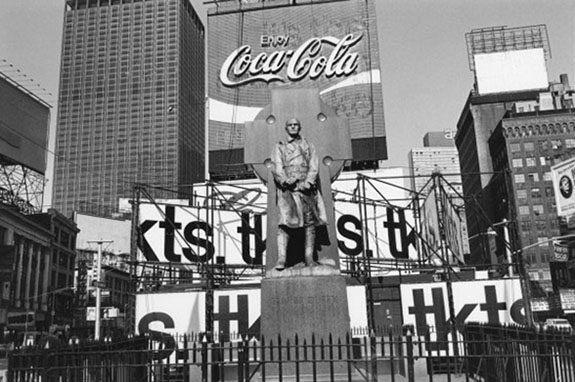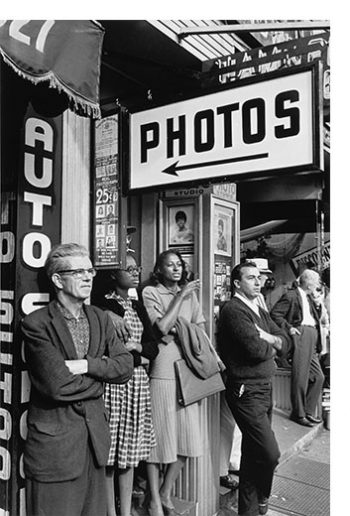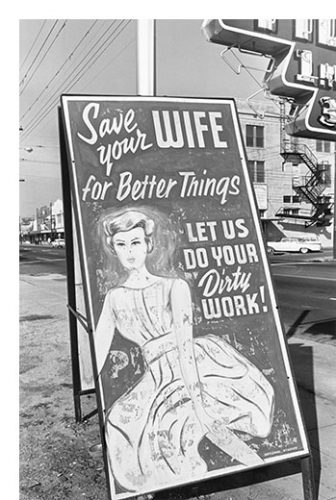by George Philip LeBourdais

If any single Lee Friedlander image could sum up America it would be New York City, 1974. The picture, part of an exhibition called Signs, shows the figure of Father Francis Patrick Duffy, whose statue has stood at the northern end of Times Square since 1909. Behind this likeness of the lauded World War I fighting priest tumble an array of enticements: advertisements for TKTS, a vendor for Broadway and Off-Broadway theater tickets that opened a year before the picture was taken. Above it all is a pulsating Coca-Cola sign that has presided over that corner of 49th and Broadway for nearly a century. The picture packs in a lot of Americana: celebrations of military glory, immigrants, religion, calls to spectacle, performance and entertainment, and the bazaar that compels us to innocently consume. Millions of people have seen this view or others like it, but Friedlander, with his dry wit and clever composition, reminds us how certain places reflect the unquestioned or unnoticed hierarchies, compulsions and temptations of American life.
However on the nose the photograph is, it's certainly not the most beguiling of those the gallery selected to represent the photographer’s "five-decade-long obsession" with how advertisements animate, enliven and confuse our visual landscape. Friedlander has been recognized as one of photography's great modernist poets since at least 1967 when MoMA's legendary photography curator John Szarkowski featured his work along with Garry Winogrand 
Through wry and intimate apercus of ads in San Francisco, Chicago, New Orleans, New York and quieter places in between, Signs captures not only the riveting story of 20th-century American cities, but also Friedlander's own debts to photographic history. By turning his lens towards painted window lettering, mounted signs and pasted flyers, Friedlander often joins a proliferation of different planes within the frame. Reflections in compositions like Chicago, Illinois, 1968, Dallas Texas, 1976, Nashville, Tennessee, 1968 and Chippewa Falls, Wisconsin, 1986 that call to mind early 20th-century Parisian storefronts of Eugene Atget. If New York once stole the idea of modern art from Paris, then Friedlander’s signs could make the claim that the United States rewrote the story of France’s elegant boulevards with bolder, more brazen appeals to consumer culture.
While Atget certainly echoes in a number of the prints, the eminence grise of this show is Walker Evans. (Worth mentioning is the Getty’s 1998 book Walker Evans: Signs, which holds a spirited essay by Andrei Codrescu; save for two puckish epigraphs, Fraenkel’s 112-page catalog for the show lets Friedlander’s signs speak for themselves.) Wearing his erstwhile love of literature on his sleeve, Evans’ early photographic work elevated the new visual language of American consumer culture and was clearly the major influence on Friedlander. The first plate in Fraenkel’s lovely (and large) book, for instance, nods knowingly at Evans’ formative work. Newark, 1962, for example, captures black and white folks leaning against the entrance of a portrait studio. With typical Friedlander irony, none of these people seem to realize he’s taking

One more example too charming to hold back: While we all have to wrestle with our forebears for original ideas, not all of us are lucky enough to travel with them, as Friedlander did with Evans. Documenting their collaborative friendship is an unassuming picture, Old Saybrook, Connecticut (1974), of Evans crouching at the edge of a suburban driveway. Hesitant, uneven letters on the metal sign being photographed by Evans read, “West st. DEAD END Do – Not Enter.” Alert viewers may recognize the spray-painted scrawl of the words “DEAD END.” It
You could play this game of semantic tag for a while, but Friedlander’s personal style stands on its own. Two consistent features make it distinct. First, his prints are often higher-contrast and brighter in exposure than Evans’. Second, he pitches his irony pretty high with calculated compositions and a willingness to walk right up to scenes where America’s contradictions are still raw. One theme that he makes unavoidable, and that runs even more powerfully through the book, is the racial divide that defines black and white life in the United States. Here, we can appreciate the work of a photographer who not only loves a good pun, but who is also committed to exposing the underbelly of America’s slick facade.
Other sign-based pictures by Friedlander and others, including Alec Soth, Richard Misrach, and an E.J. Bellocq Storyville picture printed by Friedlander, hang in Fraenkel’s two back galleries; but it’s the wonderful salon-style installation in the main room that is the exhibition’s main attraction. The arrangement fits Friedlander especially well, conveying the spontaneous, confused and often lyrical quality of life on America’s streets. This calls to mind another of Friedlander’s beloved subjects, jazz, and how certain motifs, whether musical or visual, respond to and enhance one another. It’s a show sensitive to artistic rhythms that will leave you, despite its odd melancholic notes, feeling sharp and upbeat.
# # #
Lee Friedlander: “Signs” @ Fraenkel Gallery through August 17, 2019.
About the author:
George Philip LeBourdais is a historian of American art and photography. His exhibitions and writing have earned awards from the Andrew W. Mellon Foundation, the Clark Art Institute, and the U.S. Fulbright Commission, among other institutions. A Mainer by birth, he holds a Ph.D. in art history from Stanford and lives in San Francisco.